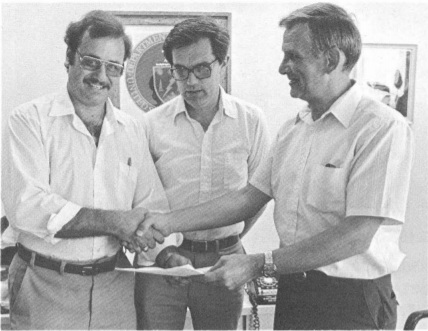Superconducting Magnet Awarded Patent
A superconducting magnet developed by scientists at Fermilab has been awarded U.S. Patent 4,189,693.
The inventor is John A. Satti, a project engineer with the Satellite Refrigeration Support Group, Energy Saver Division. The assignee is the United States of America as represented by the U. S. Department of Energy.
The magnet was designed to meet the rigorous demands of beam lines. One is installed in the Proton West high intensity secondary beam line. The four-foot-long dipole prototype magnet can reach a field strength of 4.2 tesla at 210 amperes. It has a six-inch diameter bore tube.
Essentially it is a low-current unit that has good cryogenic stability, explained Satti. One of the unique features of this magnet, one that helped earn its design a patent, is that it's constructed with an insulated strand cable. This was done to create what Satti calls a sponge-like coil containing many small grooves through which liquid helium can flow, absorbing any heat generated in the coils. The liquid helium is in intimate contact with the superconducting wires, considerably enhancing the cryogenic stability of the magnet.
"The low current configuration is achieved by winding the coil with the cable consisting of 15 electrically insulated strands which are ultimately connected in series," said Satti. "The insulated cable concept also leads to an ideal quench protection by induction coupling. This coil protection works automatically and does not rely on mechanical or electronic devices. This method built in the coil is used to deposit the energy evenly through the coil in case the conventional parallel resistor method fails. Recent tests on coil number three showed the induced coupling to be very effective."
Because the magnet draws low current—an extremely attractive feature—the refrigeration load on it (and the other magnets that eventually will come) is much less than for magnets that require higher currents. Most refrigeration is lost through the leads that carry current to and from the magnets. The greater the current, the hotter the leads get. Consequently, more refrigeration is required to cool them. Since a secondary beam line has many pairs of leads, the low-current feature is quite important.
Satti began working on the design of a secondary beam line magnet in the fall of 1975 following a series of meetings by Fermilab scientists about the demanding conditions such a magnet needed to meet. He was head of the Cryogenic Support Group, Neutrino Department, at the time.
After one year, he joined the Proton Department as leader of the Superconducting Magnet Group. Most of the work was done on the magnet during the four years he was with the Proton Department. In January of this year, he was transferred to the Energy Saver Division.
Satti has been with Fermilab since Jan. 1, 1968. He is employee number 72.
The patent for this superconducting magnet was first applied for on Jan. 3, 1977. It was issued Feb. 19, 1980, but it was not until early last month (July) that the final details had been cleared.
Although technological achievements at Fermilab have been the source for a number of patents, this has been the first one issued for a superconducting magnet.
"Superconducting magnets of various kinds must be constructed so that they are not destroyed by the electrical energy that must be dissipated when they are quenched," said Satti. "Such coils must also be built to withstand the extremely large forces that are generated by interactions among parallel currents of large values.
"Superconducting magnets intended for use in particle accelerators, in addition, must be able to dissipate the deposited energy that is associated with the presence of occasional stray particles of high energy. This heat, of course, must be absorbed by the cooling system in such a manner that the magnet does not quench--lose its superconducting ability. This magnet's coil and overall design makes it ideal for beam line use."




